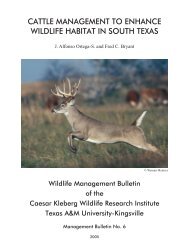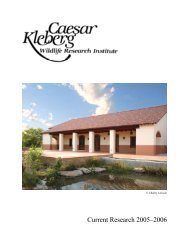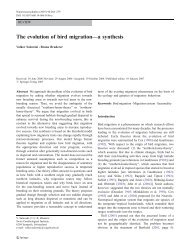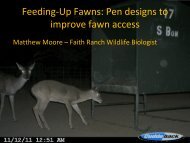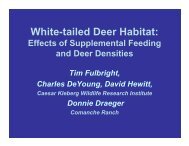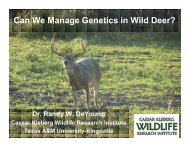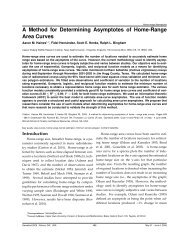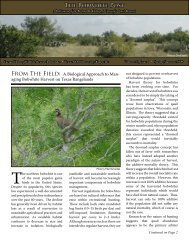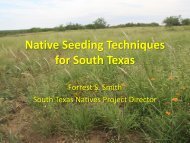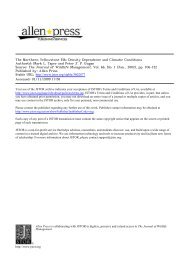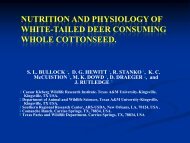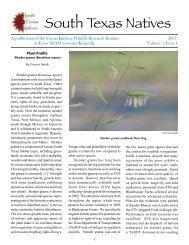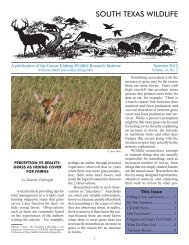HISTORY OF RANGE SEEDING IN SOUTH TEXAS JULY 2011
HISTORY OF RANGE SEEDING IN SOUTH TEXAS JULY 2011
HISTORY OF RANGE SEEDING IN SOUTH TEXAS JULY 2011
Create successful ePaper yourself
Turn your PDF publications into a flip-book with our unique Google optimized e-Paper software.
<strong>HISTORY</strong> <strong>OF</strong> <strong>RANGE</strong> <strong>SEED<strong>IN</strong>G</strong> <strong>IN</strong> <strong>SOUTH</strong><br />
<strong>TEXAS</strong><br />
<strong>JULY</strong> <strong>2011</strong><br />
John Lloyd-Reilley<br />
E. “Kika” de la Garza<br />
Plant Materials Center<br />
Kingsville, Texas
History of Plant Research by the<br />
King Ranch
Robert Kleberg, Sr.<br />
• Started testing grasses<br />
and legumes<br />
• 1900-1925
Robert Kleberg, Sr.<br />
Philosophy<br />
• If we settled for things the way they were, we would<br />
be herding English cattle and developing shade<br />
structures for them instead of developing the Santa<br />
Gertrudis breed.<br />
• We aren’t going to settle for native grass that you<br />
have to protect.<br />
• We are going to introduce or develop a hardy grass<br />
that suits South Texas and the Santa Gertrudis breed.
African Rhodesgrass (Chloris gayana)<br />
1915-1942
African Rhodesgrass<br />
• Over 75,000 acres<br />
planted on the King<br />
Ranch by 1943.<br />
• “WONDER GRASS”<br />
• Carrying Capacity:<br />
– 1 head /25 acres<br />
untreated native range<br />
– 1 head /6 acres after<br />
clearing<br />
– 1 head /3 acres with<br />
Rhodesgrass
African Rhodesgrass<br />
• 1943 was the last crop<br />
• Scale (Antonina<br />
graminis) devastated 74<br />
species of grass in 63<br />
Texas counties<br />
• Dr. Paul Riherd at the<br />
Weslaco Experiment<br />
Station developed a<br />
biological control with<br />
the use of a small wasplike<br />
parasite Anagyrus<br />
antoninae.
• In the early 1940’s USDA had a grass nursery<br />
at Texas A&I<br />
• Nico Diaz was the SCS agronomist.<br />
– In 1943 he was hired by the Ranch.<br />
• The 3 entities entered into an agreement<br />
– The Ranch would provide 200 ac. And plant grass<br />
seed from the Texas A&I nursery plots.<br />
– After2 yrs. The experimental plantings became the<br />
property of the Ranch.
• WW II interrupted the plan.<br />
• But 2 species did reveal themselves from the<br />
early trials<br />
– Kleberg bluestem<br />
– Slender grama
Nico Diaz<br />
• Grass Philosophy<br />
– A grass needed to be:<br />
• Aggressive<br />
• Palatable<br />
• Hardy<br />
• Kleberg bluestem<br />
• K.R. bluestem
• Tested Natives as Well as Exotics<br />
– Seacoast bluestem<br />
– Sandhill grass (Brachiaria ciliatissima)<br />
– Gulf cordgrass<br />
– Curly mesquite<br />
– Buffalograss<br />
– Plains bristlegrass<br />
– Texas grama<br />
– Hooded windmillgrass<br />
– False Rhodes grass
• Research Observation:<br />
– Native plants have already demonstrated their<br />
ability to survive and do well under existing<br />
fertility conditions
<strong>HISTORY</strong> <strong>OF</strong> <strong>RANGE</strong> <strong>SEED<strong>IN</strong>G</strong><br />
Not Just About the Species<br />
but also<br />
About the Equipment
Prior to WWII little seeding done.<br />
• Nibset Seeder precursor to the rangeland drill
Truax Rangeland Drill
• 1910-1930 - 17,000 acres (steam engines)<br />
• 1936-1953<br />
Cabled – 10,700 acres<br />
Dozed - 103, 998 acres<br />
Root Plowed - 141,264 acres<br />
Sprayed - 100,162 acres
Cabling or Chaining
Dozer with Root Rake
Rootplow
Roller Chopping
Aerial Spraying
Aerial Seeding
South Texas in 1950<br />
•Brush clearing extensive<br />
acreage<br />
•Seeding –Buffelgrass, Blue<br />
Panicgrass, Rhodesgrass,<br />
Kleberg and K.R. Bluestems
Buffelgrass
Blue Panicgrass
Rhodesgrass (Chloris gayana)
Kleberg Bluestem
K.R. Bluestem
South Texas in 1960<br />
•Brush clearing extensive acreage<br />
•Seeding – Kleingrass, Buffelgrass,<br />
Wilman Lovegrass, Bermudagrass<br />
Kleberg and K.R. Bluestems
Kleingrass
Wilman Lovegrass
BERMUDAGRASS
Key Points - Then<br />
• Cattle was the #1 Priority<br />
• Fuel was Cheap
South Texas in 1990<br />
•Less Brush Clearning<br />
•Increased Interest and Demand for<br />
Natives<br />
•Switchgrass, Sideoats Grama,<br />
Green Sprangletop
Switchgrass
Sideoats Grama
South Texas in 2000<br />
•Dr. Ocumpaugh promoting<br />
legumes<br />
•STPMC Releases 3 Native Grasses<br />
– Big Sacaton, false Rhodes grass,<br />
and Canada Wildrye
South Texas Natives<br />
2001<br />
An initiative to develop and<br />
promote native plants for<br />
restoration and reclamation<br />
of habitats on private and public<br />
lands
Key points - Now<br />
• Fuel isn’t cheap<br />
• Don’t seed if you don’t have to<br />
• Seed for diversity
"The U.S. Department of Agriculture (USDA) prohibits discrimination in all its<br />
programs and activities on the basis of race, color, national origin, age, disability,<br />
and where applicable, sex, marital status, familial status, parental status, religion,<br />
sexual orientation, genetic information, political beliefs, reprisal, or because all or<br />
a part of an individual's income is derived from any public assistance program.<br />
(Not all prohibited bases apply to all programs.) Persons with disabilities who<br />
require alternative means for communication of program information (Braille,<br />
large print, audiotape, etc.) should contact USDA's TARGET Center at (202) 720-<br />
2600 (voice and TDD). To file a complaint of discrimination write to USDA,<br />
Director, Office of Civil Rights, 1400 Independence Avenue, S.W., Washington, D.C.<br />
20250-9410 or call (800) 795-3272 (voice) or (202) 720-6382 (TDD). USDA is an<br />
equal opportunity provider and employer."



